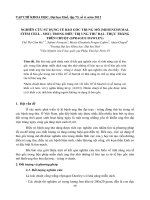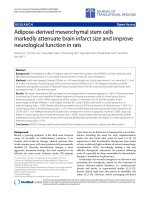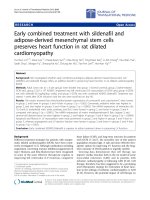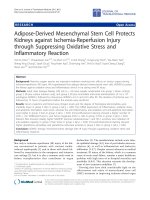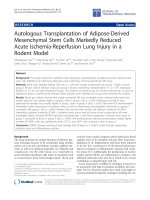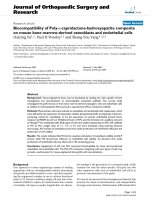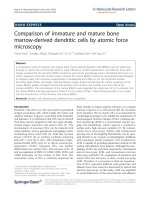Bone marrow derived mesenchymal stem cell (BM MSC) application in articular cartilage repair 4
Bạn đang xem bản rút gọn của tài liệu. Xem và tải ngay bản đầy đủ của tài liệu tại đây (4.47 MB, 4 trang )
70!
Preliminary results confirmed that we could perform the MR imaging of the pig
knee to detect as few as 100 simulated cells in the defect. According to our
simulated labeled cell MRI and the results of the normal mini-pig knee MRI
(figure 3.13), we chose the FSE PD FS (proton density fast spin echo
sequence with fat saturation) sequence for a better anatomical description
and 3D-GRE sequence as an iron sensitive sequence to visualize the
presence of the iron labeled cells in the knee.
!
Figure 3-13. MR sequence optimization.
Different MR sequences performed to choose and optimize the best
anatomical resolution for the mini-pig articular cartilage. FSE PD Fat Sat (A),
2D GRE (B), 3D FIESTA (C), 2D MERGE (D), SE MT (E), SE No MT (F).
3.4.7.2 MRI of the mini-pigs’ knee
MRI was performed on normal knee before the surgery (no cartilage defect),
one week after creating the defect (before cell injection), immediately after cell
injection, 2 weeks and 6 weeks after autologous MSC injection (1 x 10
7
).
71!
Figure 3.14 showed the location of the bulk of MSC immediately after the
injection.
!
Figure 3-14. Post injection MR images.
MR images of the mini-pig knee joint immediately after the 10
7
labeled MSCs
injection in the knee capsule. FSE PD sequence (A) provided more
anatomical data and 3D-GRE sequence (B) provided the labeled cell
localization data. (Arrowheads show the distribution of the labeled cells in the
knee joint)
MSCs were distributed in different places of the knee (figure 3.14). The
labeled cells migrated to different locations over time including cartilage
defect, injection site, surgery scar, and supra-patellar fat and the cartilage
defect site. It is likely that the healing process and the secretion of pro-
inflammation factors associated with remodeling and repair of the injury
provided the stimuli for MSC migration. MRI revealed that the injected cells
were in defect site, para-patellar fat and injection site of the knee joint (figure
3.15 and 3.16).
72!
!
Figure 3-15. MR imaging of the mini-pig's femoral condyle.
MR imaging of the mini-pig’s femoral condyle before defect creation (normal),
one week after making the defect (before injection), immediately after
injection, two and six weeks after the cells injection. Upper panel (right knee)
show the knee injected with HA plus labeled MSCs, however lower panel (left
knee) shows the HA only injection (control knee). (Arrowheads indicate the
defect site and arrows demonstrate the labeled stem cells)
73!
!
Figure 3-16. MRI of the distribution of the labeled MSCs in the mini-pig
knee joint.
The labeled cells migrated to the para-patellar fat tissue (A) and surgical scar
in the skin (B).
3.4.8 Postmortem analysis
Histological grading scores of the repaired cartilage (calculated based on
Wakitani scoring system at table 3.1) were compared between the scaffold
only and scaffold plus MSCs groups and showed a significant difference in the
cell morphology (hyaline cartilage production) (p=0.007) and matrix
production staining (p=0.011). These data suggested that intra-articular
injection of MSC could improve repair procedure by production of a higher
quality cartilage (hyaline cartilage rather than fibrocartilage). However,
histological grading analysis of the surface regularity (p=0.227), cartilage
thickness (p=0.170) and integration to the adjacent cartilage (p=0.180) failed
to reveal any significant improvement. The overall score confirmed that intra-
articular injection of MSC enhanced cartilage repair (p=0.024) (figure 3.17).
